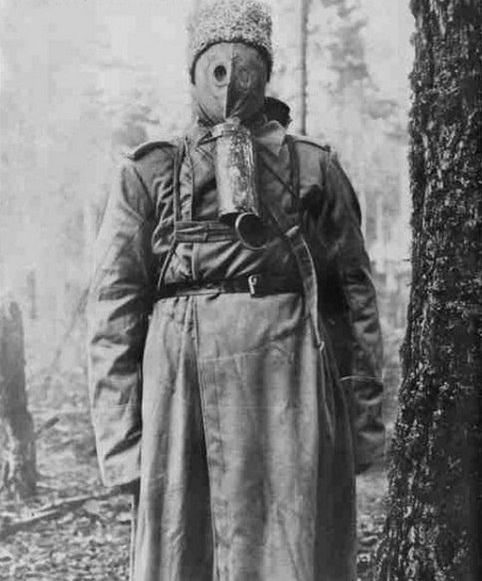
The mask was created to provide reliable protection against chlorine and phosgene gas. The small box respirators were introduced into the British and Imperial forces on the Western Front (World War I) in 1916. History of use Chemical Gas Attacks Members of the Irish Guards conduct a test with P helmets before going into combat. The canister, which was oval shaped, contained cotton and wire gauze filters to retain any poisonous substances. The rubber hose is around 30 cm in length and is made of vulcanized stockinette fabric making the hose flexible and strong. The mouthpiece is joined by a brass tube to the rubberized hose leading to the canister. The mask contains an internal mouthpiece with an exhale valve made of black rubber consisting of a flange to fit both mouth and teeth. A circular wired nose clip with rubber covered jaws sits between the internal region of the eyes. The circular eye pieces are set in metal rims that are consistent of celloid which is sealed on with rubber sealant. Khaki cotton tape, located in the middle of forehead region of the mask, connects to black elastic strips from the cheeks to ascertain a suitable fit for the carrier.

The respirator mask is light in weight and is made from khaki cotton fabric that is plated with a thin layer of black rubber. The small box respirator consists of a face mask made of rubberized fabric connected by a rubber fabric hose to a canister made of tinplate containing a chemical absorbent. Light and reasonably fitting, the respirator was a key piece of equipment to readily protect the respiratory health of soldiers on the battlefield.

Death rates were high with exposure to both the mixed phosgene chlorine and mustard gas, however with soldiers having readily available access to the small box respirator, death rates had lowered significantly.
#Wwi gas mask ukp skin
A later and more toxic gas, mustard gas, was created by Germans and was a vesicant that burnt the skin of individuals that were exposed to it. The respirator offered a first line of defense against the gas. In late 1916, the respirator was introduced by the British with the purpose to provide reliable protection against chlorine and phosgene gas. The small box respirator was the initial compact version of the recent gas mask. A British soldier wearing the Small Box Respirator during World War I


 0 kommentar(er)
0 kommentar(er)
